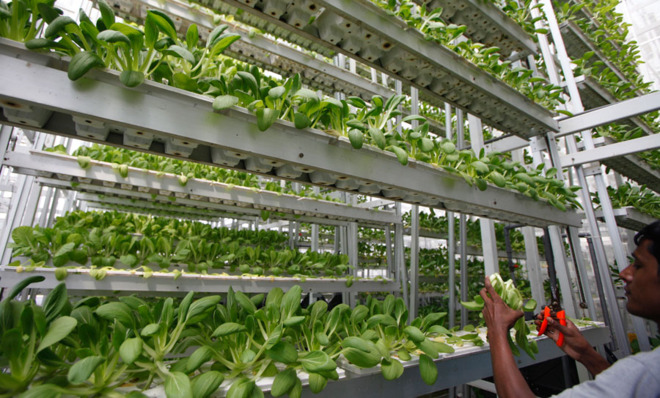How to solve global warming in 2 easy steps
It starts with a skyscraper full of vegetables


Most clear-thinking people can see by now that there isn't going to be a functioning global carbon emissions abatement scheme in the foreseeable future. Whether or not that's a good thing (and I think it is) is a separate question. Because regardless, we should look at the world as it is.
Now of course, excessive carbon emissions into the atmosphere remain a serious concern and a real problem. So what can we do to solve it?
First, let's look at the main sources of carbon emissions. The two big ones are energy production and agriculture, which is set to explode over the next decades as billions of human beings get out of food insecurity. If we get those two carbon emissions sources under control, we've solved the problem.
The Week
Escape your echo chamber. Get the facts behind the news, plus analysis from multiple perspectives.

Sign up for The Week's Free Newsletters
From our morning news briefing to a weekly Good News Newsletter, get the best of The Week delivered directly to your inbox.
From our morning news briefing to a weekly Good News Newsletter, get the best of The Week delivered directly to your inbox.
Second, we should be real: We're not going to solve this problem through policy mandates. India and China and Africa aren't going to consign hundreds of millions of their people to more poverty than they have to just to be nice to the United Nations or the European Union.
Instead, what we need is better technology. Is it possible? Well, let's look at what we can do with technology that already exists, or is in the lab.
Agriculture looks like the trickiest one, but actually, it's not. There is a nonspeculative technology we can use to dramatically reduce the carbon emissions of agriculture. It's called the vertical farm.
A vertical farm is exactly what it sounds like: a skyscraper-greenhouse. There is nothing fundamentally undoable about a vertical farm. After all, we know how to build skyscrapers, and we know how to build greenhouses.
A free daily email with the biggest news stories of the day – and the best features from TheWeek.com
A vertical farm would have an immense amount of benefits. Indoor farming can produce crops year-round, increasing the yield of the "land." Indoor farming would also mean the end of weather-related agricultural problems. The produce would be organic or near-organic since there would be little need for pesticides to protect against the pests of the natural world. Because crops could be produced within the city, the cost (both in terms of carbon and dollars) of transport would be drastically reduced. Almost everything within the vertical farm environment could be recycled.
In other words, vertical farms allow us to feed arbitrarily large numbers of people with high-quality food and with negligible environmental or operating economic costs.
So why don't we see vertical farms all around us? Actually, a few commercial vertical farms exist here and there. But they're not everywhere because even though the operating costs would be low, the startup costs are high. You need to build the thing. And given the exorbitant agricultural subsidies that exist in most Western countries, it's not a slam dunk that vertical farm-produced goods would be competitive, at least not without significant economies of scale.
The other big carbon emissions problem is energy. What can we do there? (Besides buying up all the carbon.)
As large numbers of experts have been saying, there is an obvious solution: nuclear power. My home country of France has had safe and plentiful and cheap and clean nuclear power for over 40 years, making it the rich country with the world's lowest per-capita carbon emissions. (Germany, meanwhile, is giving up its nuclear power and replacing it, mostly, not with only-intermittently-productive renewables, but with carbon-spewing coal and natural gas.)
Current forms of nuclear power, which use bars of uranium and plutonium, have well-known drawbacks: enormously expensive startup costs; waste processing costs; the risk of ecological disaster; proliferation.
I have already argued that nuclear power based on thorium, not plutonium or uranium, is very likely to have all the upside of traditional nuclear power without any of those downsides.
There is another version of this, called pebble-bed reactors, which are already being explored in China. These reactors also use uranium, not as massive bars, but rather, as small bits of uranium embedded in balls made of graphite. Because of the physics of nuclear fission, such "pebbles" cannot overheat enough to cause a reactor meltdown, unlike uranium bars, and the ensuing waste is much less radioactive.
But equally important, other features make pebble-bed reactors interesting. First of all, a pebble-bed reactor would be modular, meaning you could add more pebbles and more reactors to your plant as you go along, making startup costs very cheap and scalability relatively easy. And more important, the pebble-bed reactor makes it very easy to extract hydrogen from water — hydrogen that could then be used to power fuel-cell cars.
In a pebble-bed world, all carbon-based sources of energy would be permanently removed from the equation, whether we're talking about coal-fired power plants or oil-powered cars.
That's a nice wish list, you might say, and where's the magic wand to make it happen? Well, I don't blame you for being skeptical.
These technologies are speculative in the sense that most people aren't aware of them and aren't thinking about them (unlike, say, solar panels), but they aren't speculative in the sense that they don't require some big technological breakthrough to happen in the future (unlike, say, solar panels, which are still tremendously inefficient). What we need to implement these solutions is to prove the concept, to prove that these things are actually doable, and then global demand for cheaper, better food, and cheaper, cleaner energy should do the rest.
Do we need a government program to pull this off? Well, I can't say no. But the technologies are advanced enough that ambitious private investors with access to lots of capital could make them happen. Word to the wise...
Pascal-Emmanuel Gobry is a writer and fellow at the Ethics and Public Policy Center. His writing has appeared at Forbes, The Atlantic, First Things, Commentary Magazine, The Daily Beast, The Federalist, Quartz, and other places. He lives in Paris with his beloved wife and daughter.
-
 Trump’s poll collapse: can he stop the slide?
Trump’s poll collapse: can he stop the slide?Talking Point President who promised to ease cost-of-living has found that US economic woes can’t be solved ‘via executive fiat’
-
 Codeword: December 7, 2025
Codeword: December 7, 2025The daily codeword puzzle from The Week
-
 Crossword: December 7, 2025
Crossword: December 7, 2025The daily crossword from The Week
